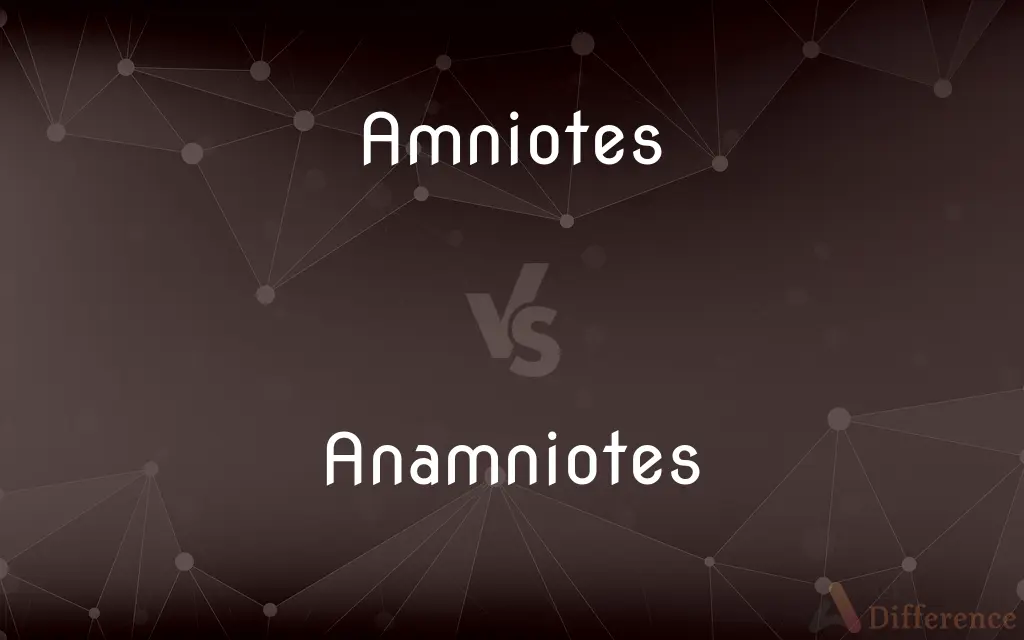Amniotes vs. Anamniotes — What's the Difference?
By Tayyaba Rehman & Urooj Arif — Published on February 6, 2024
Amniotes are vertebrates with an amniotic egg, including reptiles, birds, and mammals. Anamniotes lack this egg and include amphibians and fish.

Difference Between Amniotes and Anamniotes
Table of Contents
ADVERTISEMENT
Key Differences
Amniotes are a group of vertebrates distinguished by the presence of an amniotic egg, which facilitates a more advanced reproductive strategy and greater independence from water. Anamniotes, on the other hand, encompass vertebrates like fish and amphibians that do not possess an amniotic egg, typically requiring a water environment for their reproductive processes.
The amniotic egg of Amniotes is characterized by several membranes that protect and nourish the embryo, allowing for development in a terrestrial environment. Anamniotes lack these specialized structures, resulting in their embryos being more dependent on aquatic environments or external moisture for development.
Amniotes include a broad range of species such as mammals, birds, and reptiles, all adapted to life on land to varying degrees. Anamniotes, including amphibians and fish, are generally more tied to aquatic habitats due to their reproductive and developmental needs.
The evolutionary split between Amniotes and Anamniotes marks a significant divergence in vertebrate evolution. Amniotes evolved adaptations for a fully terrestrial life cycle, while Anamniotes retained many primitive features related to a more aquatic existence.
In terms of physiological adaptations, Amniotes generally have more advanced systems for water conservation and respiration suitable for a terrestrial lifestyle. Anamniotes, however, often exhibit features more aligned with aquatic living, such as gills in fish and permeable skin in amphibians.
ADVERTISEMENT
Comparison Chart
Egg Type
Amniotic egg with protective membranes
No amniotic egg; external or aquatic development
Habitat
Primarily terrestrial
Often aquatic or semi-aquatic
Examples
Mammals, birds, reptiles
Fish, amphibians
Reproduction
Less dependent on water
Generally requires water
Physiological Adaptations
Adapted for terrestrial life (e.g., water conservation)
Adapted for aquatic life (e.g., gills in fish)
Compare with Definitions
Amniotes
Amniotes have adaptations for terrestrial living.
The scaly skin of reptiles, a characteristic of amniotes, aids in water retention.
Anamniotes
Anamniotes are vertebrates without an amniotic egg.
Frogs, as anamniotes, lay their eggs in water.
Amniotes
Amniotes are vertebrates with an amniotic egg.
Turtles, as amniotes, lay eggs with protective shells on land.
Anamniotes
Anamniotes lack the terrestrial adaptations of amniotes.
The presence of gills in fish signifies their anamniote status.
Amniotes
Amniotes are evolutionarily distinct from anamniotes.
Mammals, as amniotes, exhibit a higher degree of independence from aquatic environments.
Anamniotes
Anamniotes include fish and amphibians.
Fish, being anamniotes, reproduce and develop in aquatic environments.
Amniotes
Amniotes include mammals, birds, and reptiles.
Birds, being amniotes, have evolved various egg-laying strategies.
Anamniotes
Anamniotes typically require water for reproduction.
Salamanders, as anamniotes, return to water to lay eggs.
Amniotes
Amniotes' eggs have multiple membranes and a shell.
The hard-shelled eggs of crocodiles demonstrate their amniote nature.
Anamniotes
Anamniotes represent a more primitive vertebrate lineage.
Amphibians, as anamniotes, exhibit ancient evolutionary traits.
Amniotes
Any of numerous vertebrates of the group Amniota, characteristically having an amnion during embryonic development and including the reptiles, birds, and mammals.
Anamniotes
Plural of anamniote
Amniotes
Plural of amniote
Common Curiosities
What defines an amniote?
Amniotes are characterized by having an amniotic egg, suitable for terrestrial environments.
How do amniotes reproduce?
Amniotes reproduce with less dependence on water, laying eggs with protective shells or, in mammals, having internal gestation.
What are examples of amniotes?
Examples include mammals, birds, and reptiles.
What are the physiological differences between amniotes and anamniotes?
Amniotes have adaptations for terrestrial life, such as water conservation, while anamniotes are often adapted to aquatic life.
Are birds considered amniotes?
Yes, birds are amniotes due to their amniotic eggs and terrestrial adaptations.
How do anamniotes reproduce?
Many anamniotes lay eggs in water or have external aquatic developmental stages.
What are examples of anamniotes?
Fish and amphibians are typical examples.
Are fish considered anamniotes?
Yes, all fish are anamniotes.
What defines an anamniote?
Anamniotes are vertebrates lacking an amniotic egg, often dependent on water for reproduction.
What evolutionary advantage do amniotes have?
The amniotic egg allows greater independence from water, facilitating a wider range of habitats.
Can anamniotes live on land?
Some anamniotes, like amphibians, can live on land but usually require a moist environment.
Do all amniotes lay eggs?
Most do, but some, like many mammals, give birth to live young.
Are all mammals amniotes?
Yes, all mammals are amniotes.
Did amniotes evolve from anamniotes?
Yes, amniotes evolved from ancestral anamniote vertebrates.
Do anamniotes have any terrestrial adaptations?
Some do, especially amphibians, but they are generally more tied to aquatic environments.
Share Your Discovery

Previous Comparison
French Manicure vs. American Manicure
Next Comparison
MIDI File Format vs. MP3 Audio File FormatAuthor Spotlight
Written by
Tayyaba RehmanTayyaba Rehman is a distinguished writer, currently serving as a primary contributor to askdifference.com. As a researcher in semantics and etymology, Tayyaba's passion for the complexity of languages and their distinctions has found a perfect home on the platform. Tayyaba delves into the intricacies of language, distinguishing between commonly confused words and phrases, thereby providing clarity for readers worldwide.
Co-written by
Urooj ArifUrooj is a skilled content writer at Ask Difference, known for her exceptional ability to simplify complex topics into engaging and informative content. With a passion for research and a flair for clear, concise writing, she consistently delivers articles that resonate with our diverse audience.
















































